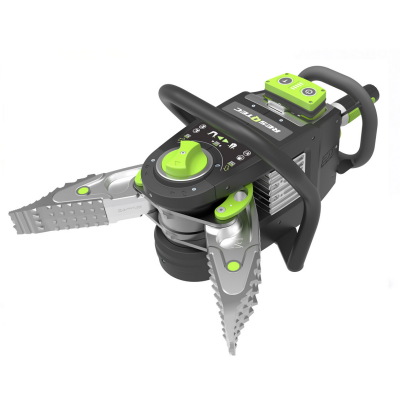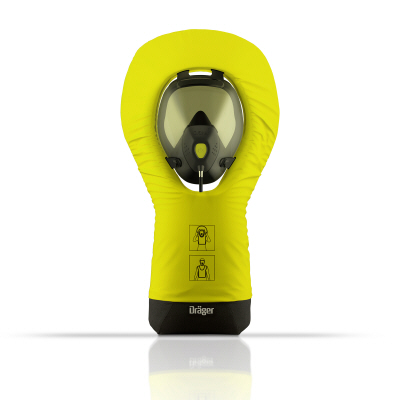Student Notable
Commercial Equipment Award
Core77 Design Awards 2016
OX-1
Thinking global, acting local:
Looking at what the future of agriculture holds, and the challenges that lie ahead, a number of papers describe what is being called the forthcoming global crisis in agriculture; namely how do we feed a population of what will be 9 billion people, when current predictions indicate that we will need to increase agricultural production by 60-70% of current levels to meet this increasing demand. One of the areas that has been shown to show some of the largest potentials for gains are in small scale agriculture, which today is responsible for feeding some 2 billion of the poorest part of the global population, which quite often still involves either manual or animal labour to get the job done. This project concept focuses on improving the future of agriculture for small scale farmers as just one channel to tackle this complex global issue.
Connecting the dots, finding a focus:
Most pre-industrial economies were so dependant on the food supply it caused almost their entire economy to be devoted to agriculture; improvements to farm productivity thus had huge impacts on the wealth of the population. One of the first steps forward in agricultural development is replacing the farmers oxen with a two-wheel tractor. This was identified as a prime design opportunity to better productivity and the quality of life for small scale farmers since two wheel tractors have remained relatively unchanged for the last 50 years. Problems such as the physical strength required to steer the machine; repetitive strain injuries from prolonged vibrations and noise exposure; changing wheels for different tasks; general road safety; and operator ergonomics were found as key areas for improvement. Analysis, understanding, and evaluation was done through field research, tutoring sessions, historical research, internet research, journals, expert interviews, second hand experiences, group brainstorming sessions, market research, scenario mapping, and user testing.
Defining the needs of the concept solution:
The end result proposes a design solution that incorporates a larger degree of functionality, flexibility, and adaptability to the two-wheel tractor platform; as well as striving to improve safety, ergonomics, and ease of use for both genders.
 Rear 3/4 View, steering turned
Rear 3/4 View, steering turned
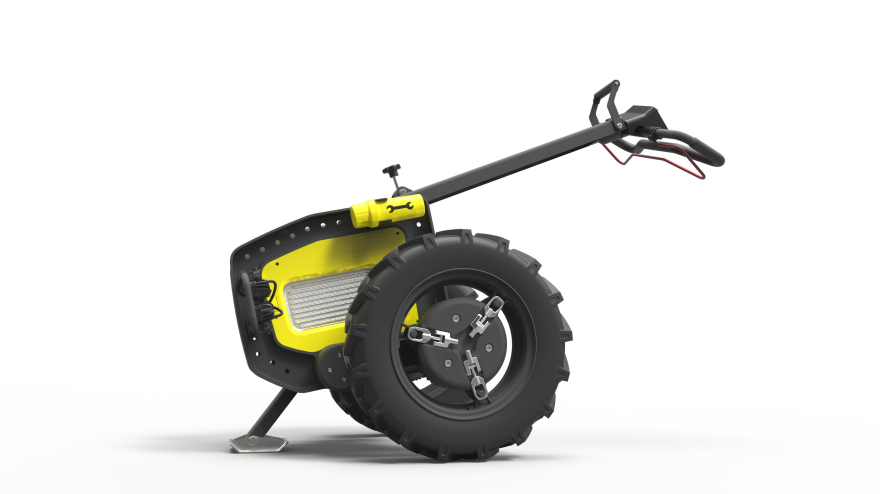 Side view, steering turned
Side view, steering turned
 Operator view, steering turned
Operator view, steering turned
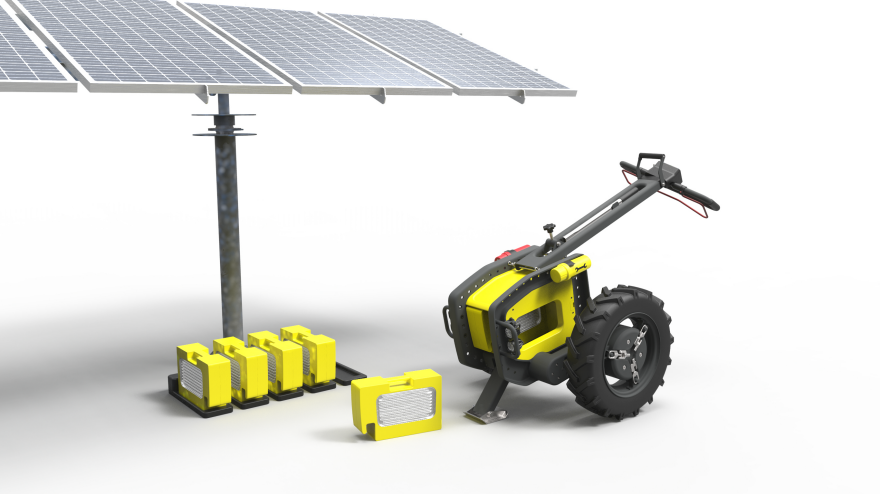 OX-1 with 1 battery removed, at solar charging station
OX-1 with 1 battery removed, at solar charging station
 Different configurations illustrating different potential uses and functions: 2 tractors in tandem for additional power; solar charging station; paddle wheels for muddy fields, with a seed bag on the optional utility rack; reverse set-up operated tractor with reaper; standard OX-1 with rototiller; reverse set-up operated tractor with forklift attachment, industrial tires, and balance wheels; wind charging station.
Different configurations illustrating different potential uses and functions: 2 tractors in tandem for additional power; solar charging station; paddle wheels for muddy fields, with a seed bag on the optional utility rack; reverse set-up operated tractor with reaper; standard OX-1 with rototiller; reverse set-up operated tractor with forklift attachment, industrial tires, and balance wheels; wind charging station.
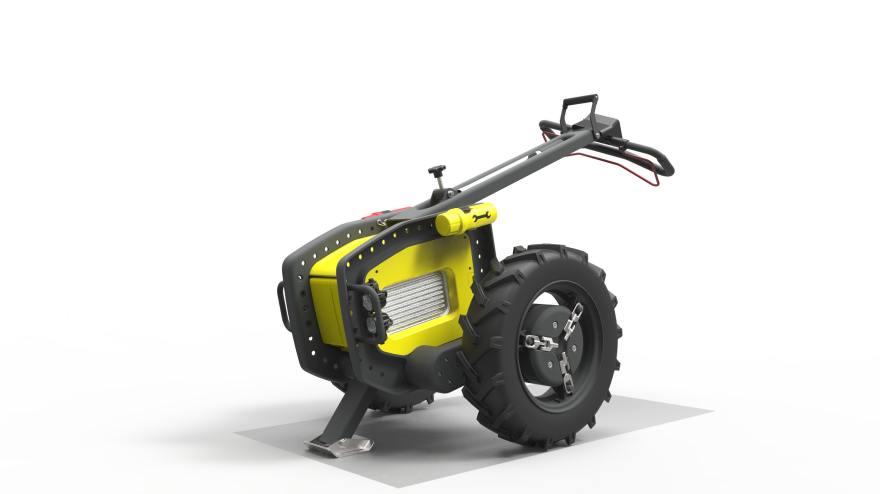 OX-1 front 3/4 view, steering turned.
OX-1 front 3/4 view, steering turned.
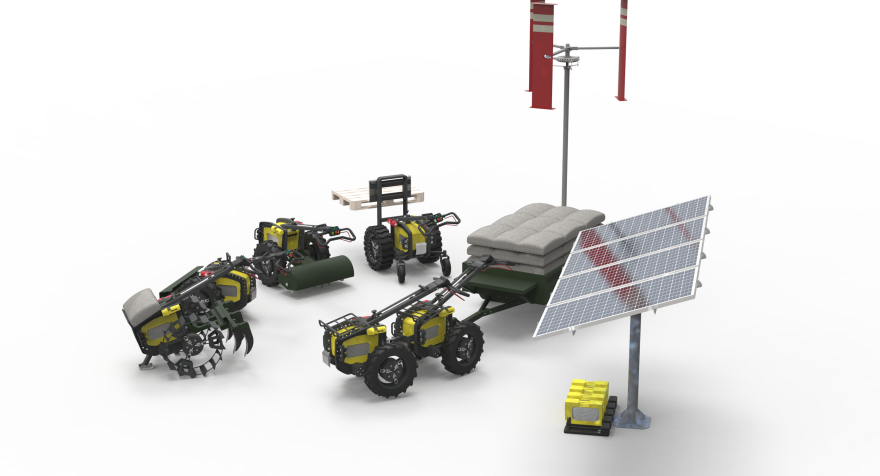 Different configurations illustrating different potential uses and functions: 2 tractors in tandem for additional power; solar charging station; paddle wheels for muddy fields, with a seed bag on the optional utility rack; reverse set-up operated tractor with reaper; standard OX-1 with rototiller; reverse set-up operated tractor with forklift attachment, industrial tires, and balance wheels; wind charging station.
Different configurations illustrating different potential uses and functions: 2 tractors in tandem for additional power; solar charging station; paddle wheels for muddy fields, with a seed bag on the optional utility rack; reverse set-up operated tractor with reaper; standard OX-1 with rototiller; reverse set-up operated tractor with forklift attachment, industrial tires, and balance wheels; wind charging station.
 Different configurations illustrating different potential uses and functions: 2 tractors in tandem for additional power; solar charging station; paddle wheels for muddy fields, with a seed bag on the optional utility rack; reverse set-up operated tractor with reaper; standard OX-1 with rototiller; reverse set-up operated tractor with forklift attachment, industrial tires, and balance wheels; wind charging station.
Different configurations illustrating different potential uses and functions: 2 tractors in tandem for additional power; solar charging station; paddle wheels for muddy fields, with a seed bag on the optional utility rack; reverse set-up operated tractor with reaper; standard OX-1 with rototiller; reverse set-up operated tractor with forklift attachment, industrial tires, and balance wheels; wind charging station.

Driving development and increasing productivity:
Two Wheel Tractors (2WT's) are increasingly common throughout rural areas in developing countries as they replace traditional ox-carts, or other forms of animal and manual labour.
2WT's have a dual function as an interchangeable agricultural implement and transport vehicle, as well as a stationary power source for threshing, reaming, milling, pumping water and so on; but additional functions/properties could bring more benefits necessary in the modern and developing world. Additionally, 2WT'shave remained largely unchanged for many years, with little to no advancements or changes in the design.
In Asia, a new 2WT — without cart — is around US$1250 for a popular model with the 9.5 hp engine and 3-gear frame. At current prices, up to 90% of the purchase price is covered by the sale of a farmer's oxen. Lao farmers reportedly receive US$900 for two 'good, big buffalo', while Cambodian farmers receive around US$1000.
One of the benefits of switching from using oxen for working fields to using a 2WT is that the farmer no longer needs to keep, maintain, and crop a certain amount of land just to feed the oxen they use to farm the rest of their land.The benefit of no longer having to grow the crops required to feed and fuel the oxen however is also countered by now having to pay for petrol to fuel the 2WT.
Shifting towards electrification in agriculture:
Combustion engines are less than 15% efficient at converting fuel energy into work. Electric motors have efficiencies of over 90%. The fact that electric motors don't idle makes them 10x more efficient than combustion engines. Electric tractors also don't have the daily maintenance costs associated with combustion engines. (source)
At Agritechnica 2013 in Germany, aside rom displaying new, market-ready machines, some agricultural machinery manufacturers used the machinery show to provide a glimpse into the engineering future. Tractors and equipment designed to use high-voltage electricity to power implement drives instead of traditional PTO or hydraulic systems have been appearing at the event since 2009. There were more concept machines advancing that technology on display again in 2013.
"If you compare the electric fertilizer spreader to the hydraulic one, we have about a 10 per cent increase in efficiency, which leads to reduced fuel consumption in the tractor, we see, also, improvements in the distribution of the fertilizer. We need quite exact disc speed. We can get that with electric drive." Michael Linz, from Rauch's electronic development division believes electric drive for implements will become the dominant system in the future. "The only question is, how long will it take," he said. (source)
Safety and Ergonomics:
There are two primary safety concerns amongst Lao and Cambodian stakeholders regarding the safety of 2WTs, specifically vehicle safety standards and the limited road use knowledge and experience of drivers. Most farmers have little road safety knowledge and experience with motorized vehicles, which is a particular problem when their first four-wheeled vehicle is both demanding to operate and inconspicuous, particularly at night (single headlights, if there are any at all, are easily confused with motorcycles or mopeds). The operating difficulties include: poor brakes (front only); a narrow front-tyre track; little or no rear-vision (the driver is seated low and in the centre of a vehicle without mirrors); and the driver is only able to steer to a very narrow angle due to the long-reach handlebars (to steer at a greater angle, the driver must get off of the vehicle and 'walk' the 2WT through the turn). Trailers are frequently wooden, and few have reflectors let alone lights. (source)
The operators of these kinds of machinery are exposed to high levels of hand transmitted vibration. Long time working with this machinery cause dynamic disorders, damaging different part of the body such as: earache, spine and digestion disorders and vascular disease. Furthermore, it causes decrease in efficiency and work. The vibration transmission characteristics of the hand-arm system are strongly related to the magnitude and dominant directions of vibration. The Vibration Characteristics of Walking and Riding Type Power Tillers were examined. The results indicate that machine vibration increased with an increase in engine speed and major excitation of the vibration of the power tiller was the unbalanced inertial force of the engine. The walking type power tiller showed higher hand transmitted vibration than the riding type during rototilling, whereas the riding type power tiller exhibited higher hand transmitted and whole body vibrations during the transport mode. It was observed that, if the power tiller is used at least 4 h per day at the forward speed of 2.4kmh-1, these disorders would appear in 4 yr, for 10% of the operators, under usual working conditions. (source)
One report found machine vibration was detrimental to the agricultural user, and recommended regular breaks for the operator—a noteworthy report from a driver fatigue perspective (Tiwari and Gite, 2006). There are also undocumented general safety concerns about exposed belts/pulleys and excessive noise.Vibration is a leading cause of RSIs. Wrapping controls in a visco-elastic material helps to absorb vibration.When using hand controls, the tractor operator should wear gloves that are padded with visco-elastic or other vibration-absorbing materials. Hand controls should be operated without excessive deviation (extension or flexion) of the wrist. The tractor operator should keep his or her wrist as straight as possible when engaging the hand controls. (source)
Proposed concept:
OX1- is an electric two wheel tractor for empowering small scale farmers in the developing world. The design is intended to be a more flexible and adaptive tool than the current solution, and be inclusive for both genders; allowing the farmer to adapt the tractor to their needs, rather than adjusting to it's limitations.
The final design creates a platform for hacking - a common tendency among farmers - by having evenly spaced holes throughout the perimeter of the frame, as a modular place to attach components to (adding balance wheels; attaching 2 tractors in tandem; putting various modifications on as needed).
In combination with micro energy production (solar/wind, etc), OX1 offers fuel independence while batteries can also serve as energy storage for the household when not used. Utilizing electric motors instead of a combustion engine almost completely eliminates noise and vibrations, solving repetitive strain injury and hearing loss issues.
Shifting the power to hub motors allows for skid-steer operation; reducing the physical demands required of the user to operate the tractor, as well as placing weight where it is needed and best used. Hub motors also means being able to easily attach the wheels to height adjustable bogies; changing heights for different needs, and making wheel changing easier and safer.In muddy fields (rice paddies), large metal paddle wheels are used, but not to get to the field, meaning wheels are changed on the side of the road. By making the wheel hub motors detach quickly from rims, this makes changing to paddle wheels, or other options easier. With adjustable wheel bogies, the tractor is quickly lowered to the ground to change wheels more safely.
Delivering the tractor with a compact tool kit, as well as first aid kit, helps allow the farmer to 'hack' the tractor for their needs, as well as supplying them with simple first aid products otherwise not present.
Very interesting for third world countries.


